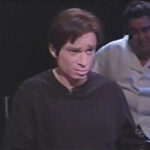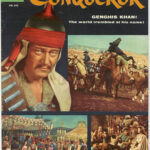John Byner, a name synonymous with uncanny impersonations and comedic brilliance, stands as a pivotal figure in the world of entertainment. Often hailed as a forerunner to modern comedic impressionists like Dana Carvey, Frank Caliendo, and Jim Carrey, this 5’7″ dynamo has carved a unique niche through his deadpan delivery, rubbery face, and an arsenal of dialects that have captivated audiences for decades. Actor John Byner’s talent extends beyond mere mimicry; he embodies the spirit of each character, bringing them to life with hilarious accuracy.
Born John Thomas Biener on June 28, 1938, in the vibrant melting pot of New York City, his journey began humbly. His father, Michael Biener, was an auto mechanic, and his mother, Christina Biener, worked as a mental hospital attendant. This ordinary upbringing belied the extraordinary talent that would soon emerge. Byner’s foray into show business started in the bohemian heart of Greenwich Village. He honed his craft at the legendary “Village Vanguard” jazz club under the mentorship of Max Gordon. This experience was instrumental in shaping his stage presence and comedic timing, opening doors to perform with jazz luminaries and establishing him as a sought-after nightclub entertainer in New York.
As actor John Byner’s star ascended, he graced the stages of the nation’s most prestigious nightclubs, including Basin Street East, Copa Cabana, and the Latin Quarter. His name became a fixture in the showrooms of Las Vegas’s iconic casinos like Harrah’s, The Sahara, The Sands, Caesar’s Palace, The Tropicana, and the Las Vegas Hilton. During his late 1960s and early 1970s peak, John Byner and Rich Little were rightfully celebrated as the kings of impressionists, the “Men of 1,000 Impressions,” dominating the comedy scene with their unparalleled ability to transform into a multitude of personalities. Byner’s repertoire was incredibly diverse, ranging from entertainment icons like John Wayne, Ed Sullivan, Walter Brennan, and George Jessel to political figures such as U.S. Presidents Richard Nixon and Lyndon Johnson. He didn’t just imitate voices; he captured the essence of each person, adding a layer of comedic exaggeration, particularly when mimicking singers like Johnny Mathis and Dean Martin with over-the-top vocal stylings.
Television became another significant platform for actor John Byner’s talents. His TV breakthrough occurred in 1964 on Merv Griffin’s “Talent Scouts Show” in New York City. This appearance paved the way for numerous spots on prominent variety shows hosted by Garry Moore and Steve Allen in 1966 and 1967. Ed Sullivan’s iconic showcase program became a recurring stage for Byner’s comedic genius, featuring him over two dozen times. Late-night television also embraced his charm, with more than three dozen appearances on Johnny Carson’s “Tonight Show.” He further cemented his status as a TV favorite with appearances on “The Carol Burnett Show,” “The Mike Douglas Show,” and “The Dean Martin Show.” Later generations also enjoyed his performances on shows hosted by David Letterman and Jay Leno, proving his enduring appeal across different eras of television.
In 1972, actor John Byner took center stage with his own summer variety series, “The John Byner Comedy Hour.” This show highlighted his versatility, focusing on sketch comedy and hilarious spoofs of popular sitcoms. His comedic vision continued to flourish with “Comedy on the Road,” an A&E series that ran for four successful seasons, earning him his second Ace Award. His first Ace Award was for the uproarious sketch comedy program “Bizarre,” which aired for six seasons and became a cult classic for its offbeat humor and unpredictable scenarios.
While making audiences laugh through stand-up and variety shows, actor John Byner also ventured into on-camera acting starting in 1967. He secured a recurring role in the sitcom “Accidental Family” (1967) and notably provided voices for the cartoon segment “Die blaue Elise” (1969), a part of “Der rosarote Panther – Zu Gast bei Paulchens Trickverwandten” series. In this role, he showcased his impression skills again, voicing characters with spot-on impersonations of Dean Martin and Jackie Mason. His acting career expanded with guest appearances on iconic 60s and 70s shows like “Get Smart,” “The Mothers-In-Law,” “Love, American Style,” “Hawaii 5-O,” “The Odd Couple,” “Maude,” and “When Things Were Rotten.” He brought his comedic flair to film as well, playing Detective Donahue in the spoof “Die Ausgeflippten” (1977) and appearing in the family sitcom “Lachen auf Rezept” (1976) alongside Danny Thomas. Although a TV movie pilot “McNamara’s Band” (1977) didn’t become a series, he continued to take on diverse roles in TV movies, ranging from comedies like “Weihnachtsmänner haben’s schwer” (1979) and “Murder Can Hurt You!” (1980) to dramas like “Nixons rechte Hand – Der Fall G. Gordon Liddy” (1982).
Actor John Byner’s film debut, though minor, was in the Barbra Streisand/Ryan O’Neal comedy “What’s Up, Doc?” (1972). While film stardom wasn’t his primary path, he added comedic support to several action comedies and slapstick films, including “The Last of the Cowboys” (1977) with Henry Fonda and Eileen Brennan, the obscure “Die H.L.M. Puff-Company” (1979), “Smokey and the Bandit Part 3” (1983) starring Burt Reynolds, and the horror-comedy “Transylvania 6-5000” (1985) with Jeff Goldblum and Ed Begley Jr.
Beyond live-action roles, John Byner’s remarkable voice talents led to a prolific career in animation. He contributed to Disney’s “The Black Cauldron” (1985) and lent his voice to beloved TV cartoon programs such as “Duckman,” “Garfield,” “Angry Beavers,” “Rugrats,” and a reimagined “Felix the Cat.” His ability to create distinct and memorable voices further solidified his reputation as a versatile performer.
Into the 1990s and beyond, actor John Byner maintained his presence in the entertainment world. He had a recurring role in the crime drama series “Palm Beach-Duo” (1991) and made guest appearances on popular shows like “Married…with Children,” “Dharma & Greg,” “In the Heat of the Night,” and “The First Family.” He also appeared in films like “Munchie” (1994), “Wishmaster” (1997), Rodney Dangerfield’s “My 5 Wives” (2000), and “Robodoc” (2009).
Married four times, John Byner has four children from his first marriage. His personal life, however, remains secondary to his extensive and impressive career. Actor John Byner’s legacy is that of a true entertainer, a master impressionist, and a versatile actor who has left an indelible mark on comedy and television. His contributions continue to inspire and entertain, making him a significant figure in the history of American comedy.


